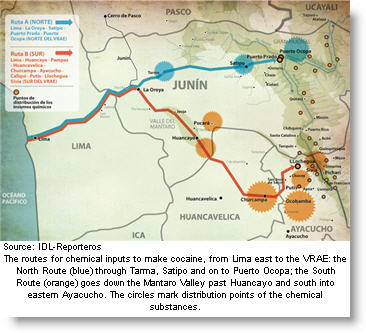Peru’s government plans to invest in building a number of facilities for state-security forces in its top coca growing region in an effort to beat back a surging cocaine trade, state news agency Andina says.
Interior Minister Wilver Calle has announced that the government is to build or improve infrastructure at 29 police stations, 11 counter-insurgency bases, and four anti-drug bases in the the region where the Apurimac and Ene Rivers come together, known by the acronym of VRAE, which will now also be extended to incorporate the Mantaro River valley in Junin further north, in the new VRAEM strategy.
The strategy also includes a more active state presence through property and commercial registry services, consumer protection and other legal offices, as well as heavy investment in social inclusion programs such as literacy programs, school education, scholarships for higher studies, and health services through the Ministries of Health, Education and Social Inclusion.
Other projects within the strategy are the 324 km ring road in the VRAE, increased access to telecommunications, and financing and advisory services for agricultural development.
Calle said the investment to increase state security presence in the area aims to control the trafficking of chemical inputs needed to turn coca leaves into cocaine (sulfuric acid, sodium bicarbonate, hydrochloric acid, potassium permanganate, acetone and kerosene).
The anti-drug bases are to be located in the districts of Mazamari, in Junin region; in Palmapampa and Huanta, both in Ayacucho region; and Kepashiato, in Cusco region. In the latter village, despite the mayor’s offer of the municipal building, police forces had taken over part of a school as their base, endangering the lives of the schoolchildren (a soldier and a young schoolgirl were injured by a Shining Path sharpshooter in April).
Kepashiato was the site of a kidnapping in April of 36 natural gas workers at the hands of remnants of Shining Path guerrillas.
While the workers were released unharmed a few days after being taken, a military-police operation aimed at tracking down the rebels resulted in a major blow to state security personnel. The Shining Path shot down a helicopter and killed nine military and police officers, which resulted in the resignation of Peru’s Interior and Defense ministers.
The heavily-armed Shining Path operates as protection for Peru’s growing cocaine trade.
President Ollanta Humala has vowed to crack down on the remaining Shining Path rebels and eliminate and pacify the coca growing region by the end of his term in 2016.
 In the aspect of controlling the inputs for manufacturing cocaine, however, investigative journalist Gustavo Gorriti does not believe the strategy will have much effect. In an article on the “dilemma of the inputs” posted on his IDL-Reporteros website, Gorriti questions why this should be successful if 40 years of eradication and interdiction strategies have failed. More importantly, added to the inevitable corruption, he points out that all the inputs except one can be substituted by other products and the remaining input can be manufactured rustically wherever the coca leaves are being macerated.
In the aspect of controlling the inputs for manufacturing cocaine, however, investigative journalist Gustavo Gorriti does not believe the strategy will have much effect. In an article on the “dilemma of the inputs” posted on his IDL-Reporteros website, Gorriti questions why this should be successful if 40 years of eradication and interdiction strategies have failed. More importantly, added to the inevitable corruption, he points out that all the inputs except one can be substituted by other products and the remaining input can be manufactured rustically wherever the coca leaves are being macerated.






Instead of spending a gazillion Soles on counter-insurgency bases and police stations, what about creating some innovative and creative ways to use the coca leaf to actually BENEFIT the PEOPLE????? Like shampoo, creams, syrups, flour, toothpaste, all those things that Peru now imports after shutting down its manufacturing industry …… the coca leaf is NOT a drug and contains a complex of fourteen alkaloids, significant amounts of vitamins A & E, plus iron, potassium, calcium – surely intelligent minds could develop the coca leaf into some fabulous products!!!! With the plan outlined in the article, there are sure to be some very unsavory consequences – small minds at work here!